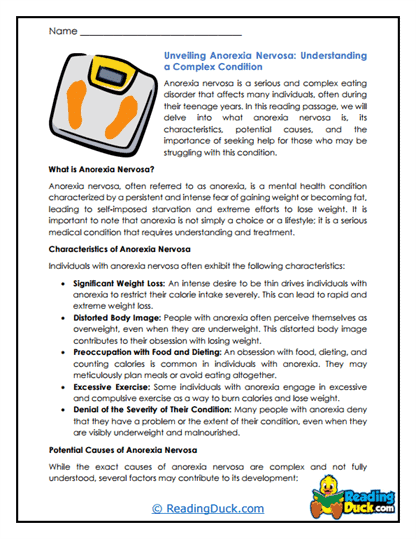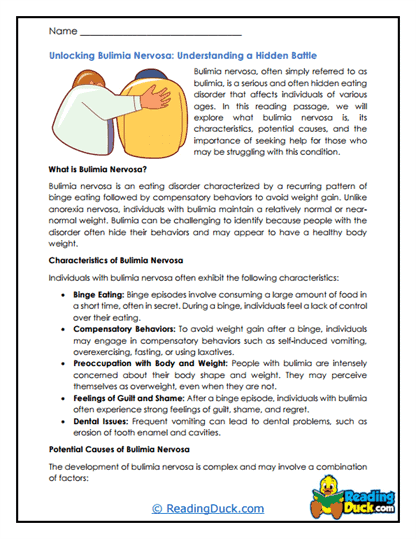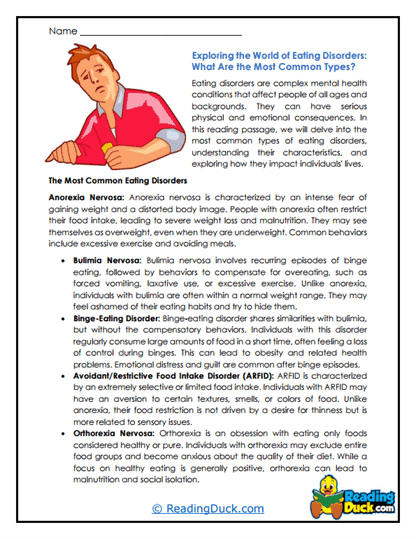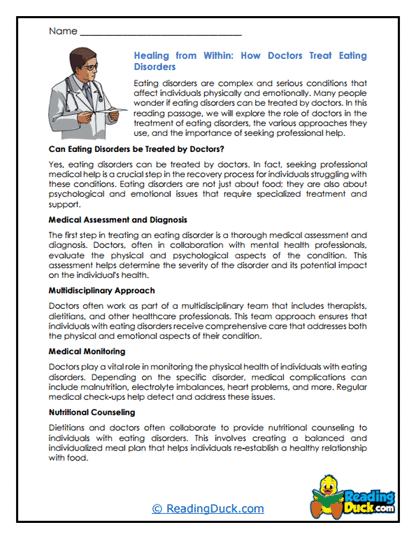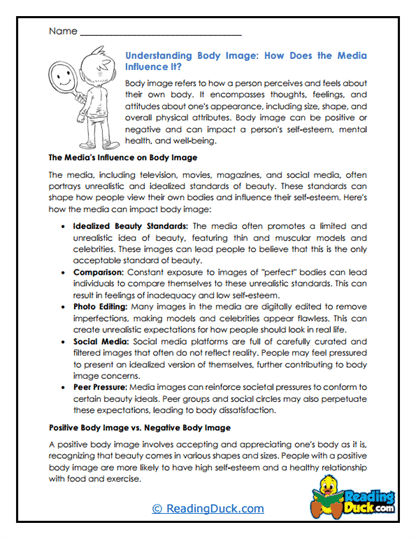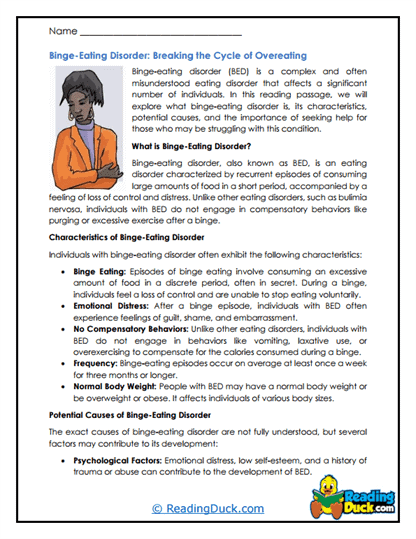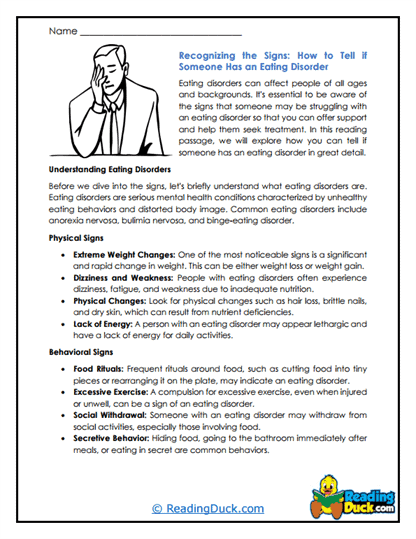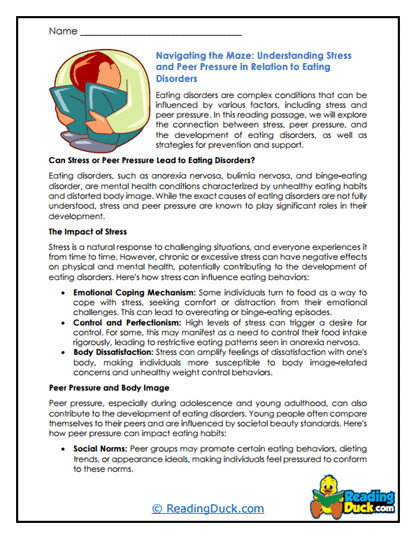Eating Disorders Worksheets
About Our Eating Disorders Worksheets
Our Eating Disorders Worksheets are designed to educate students about the complexities and challenges associated with eating disorders, helping them understand the psychological, physical, and social aspects of these conditions. These worksheets are part of the broader Health category, which covers a wide range of health-related topics such as Alcohol, Exercise, Healthy Relationships, Mental Health, Nutrition, Peer Pressure, Personal Hygiene, Substance Abuse, and Tobacco. The goal of these worksheets is not just to inform, but to empower students to make informed choices and to recognize the signs and symptoms of eating disorders in themselves and others.
This topic contains several worksheet sets, each focusing on a specific aspect of eating disorders. Each worksheet set includes:
- Multiple Choice Questions: These questions assess students' comprehension of the reading passages, focusing on key details about different types of eating disorders, their symptoms, causes, and the impact they have on individuals’ health and well-being.
- Short Answer Questions: Students provide concise responses, summarizing important information, analyzing scenarios related to eating disorders, and reflecting on the social and psychological factors that contribute to these conditions.
- Open-Ended Questions: These questions encourage students to think critically and express their personal interpretations, opinions, and preferences related to eating disorders, helping them connect the material to their own experiences and awareness.
These worksheets are designed to measure students' understanding while deepening their connection to the material. An answer key is provided for each question sheet, making it easy for teachers and parents to evaluate student progress. All worksheets are available as PDF files, which can be easily viewed electronically, downloaded, and printed.
Understanding Eating Disorders: The Realities, Risks, and Recovery
Eating disorders are complex mental health conditions that affect millions of people worldwide. They involve more than just food—they are often about control, self-image, and coping with emotional pain. It is crucial for students to understand the different types of eating disorders, the risks they pose, and the importance of seeking help. By studying eating disorders, students gain a comprehensive view of how these conditions develop, how they affect individuals and communities, and how recovery is possible with the right support.
When discussing eating disorders with students, it is important to cover a variety of key concepts and areas of interest:
- Types of Eating Disorders: There are several types of eating disorders, each with its own characteristics and challenges. Students learn about the most common types, including anorexia nervosa, bulimia nervosa, and binge-eating disorder. They explore the symptoms, behaviors, and physical consequences associated with each disorder. For example, students learn that anorexia nervosa involves extreme restriction of food intake and an intense fear of gaining weight, while bulimia nervosa is characterized by cycles of binge eating followed by purging. Understanding these disorders helps students recognize the signs in themselves or others and underscores the seriousness of these conditions.
- Causes and Risk Factors: Eating disorders do not have a single cause; they arise from a complex interplay of biological, psychological, and social factors. Students explore the various risk factors that contribute to the development of eating disorders, including genetics, personality traits (such as perfectionism and low self-esteem), cultural pressures, and traumatic experiences. They also examine how societal ideals of beauty, particularly the emphasis on thinness, can exacerbate the risk of developing an eating disorder. This understanding helps students appreciate the multifaceted nature of eating disorders and the importance of addressing both the individual and societal factors that contribute to them.
- Physical and Psychological Impact: The impact of eating disorders extends beyond weight loss or weight gain—they have serious physical and psychological consequences. Students learn about the short-term and long-term health effects of eating disorders, including malnutrition, heart problems, digestive issues, and osteoporosis. They also explore the psychological toll, such as anxiety, depression, and isolation, that often accompanies these conditions. This section emphasizes the severity of eating disorders and the importance of early intervention to prevent lasting damage.
- The Cycle of Eating Disorders: Eating disorders often follow a cyclical pattern, where disordered eating behaviors are used to cope with negative emotions, but ultimately lead to more distress and a worsening of the disorder. Students examine how this cycle works and how it can be broken through treatment and support. For example, they learn how restrictive dieting can lead to binge eating, which then triggers feelings of guilt and shame, leading to further restriction or purging. Understanding this cycle helps students identify the behaviors and thoughts that perpetuate eating disorders and the steps needed to interrupt this cycle and begin recovery.
- Treatment and Recovery: Recovery from an eating disorder is possible, but it requires professional help and a strong support system. Students explore the different treatment options available, including therapy (such as cognitive-behavioral therapy), nutritional counseling, and, in some cases, medication. They also learn about the importance of building a support network of family, friends, and healthcare professionals. This section encourages students to seek help if they or someone they know is struggling with an eating disorder and to understand that recovery is a journey that requires time, patience, and persistence.
- The Role of Media and Society: The media plays a significant role in shaping societal attitudes towards body image and can contribute to the development of eating disorders. Students analyze the impact of media portrayals of beauty and body standards, and how these can distort perceptions of self-worth and body image. They also discuss the rise of social media and its role in both perpetuating harmful ideals and providing support communities for those in recovery. Understanding the influence of media helps students develop critical thinking skills and promotes a healthier relationship with their own bodies.
- Prevention and Advocacy: Preventing eating disorders involves promoting a culture of body positivity, self-acceptance, and healthy relationships with food. Students explore strategies for preventing eating disorders, such as fostering a positive body image, encouraging balanced nutrition, and challenging harmful societal norms. They also learn about the importance of advocacy and raising awareness about eating disorders to reduce stigma and ensure that those affected receive the help they need. This section empowers students to be proactive in promoting mental health and well-being in their communities.
Through these topics, students gain a well-rounded understanding of eating disorders, their causes, and the paths to recovery. They learn to appreciate the importance of early intervention and the need for compassion and support for those affected by these conditions.
The Significance of Raising Awareness
Raising awareness about eating disorders is essential, especially as students are at an age where body image concerns and societal pressures are particularly intense. Understanding the risks and realities of eating disorders empowers students to make informed choices about their health and to recognize the early signs of these conditions in themselves and others. Early education on this topic can significantly reduce the incidence of eating disorders, promote healthier behaviors, and encourage a supportive environment where students feel comfortable seeking help.
Proficiency in this topic helps students in several ways. Academically, it enhances their critical thinking and emotional intelligence as they learn to evaluate information, reflect on their own experiences, and consider the impact of societal norms on mental health. Personally, it fosters a sense of empathy and responsibility, encouraging students to support peers who may be struggling and to advocate for healthier, more inclusive standards of beauty. Moreover, it equips students with the knowledge they need to make positive choices about their own health and well-being.
How To Use These Worksheets
These eating disorder worksheets can be effectively integrated into various subjects and classes, particularly in health education, psychology, and social studies courses. For middle school students, these worksheets introduce the basics of eating disorders, helping them understand the importance of body positivity and mental health. For high school students, the worksheets can be used to explore complex issues such as the psychological aspects of eating disorders, the impact of media, and the societal pressures that contribute to these conditions. Teachers can also incorporate these worksheets into broader discussions on mental health, self-esteem, and the role of culture in shaping our perceptions of body image.
Incorporating these worksheets into the curriculum not only reinforces key health principles but also helps students develop essential life skills, such as empathy, self-awareness, and critical thinking. By engaging with real-world scenarios and questions that require them to apply their knowledge, students build a strong foundation in mental health literacy that will serve them well throughout their lives.
Overall, the Eating Disorders Worksheets provide a comprehensive and engaging way for students to explore the complex issues surrounding eating disorders, gain a deeper understanding of their impact, and develop the skills they need to make informed and compassionate choices.
